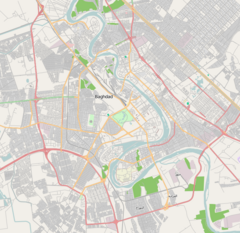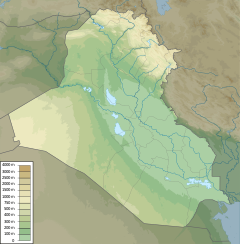Al-Rusafa, Iraq
-Rusafah
ٱلرُّصَافَة ٱلرَّصَافَة Al-Rasafah | |
|---|---|
Neighbourhood | |
| Coordinates: 33°19′54″N 44°24′55″E / 33.33167°N 44.41528°E / 33.33167; 44.41528 | |
| Country | |
| Governorate | Baghdad |
| Time zone | UTC+3 (AST) |
Rusafa or Al-Rasafa (Arabic: ٱلرُّصَافَة \ رَّصَافَة, romanized: Ruṣāfah / Ar-Raṣāfah) is one of the nine administrative districts in Baghdad, Iraq, on the eastern side of the River Tigris (on the west side of which is Al-Karkh). It is one of the old quarters of Baghdad, situated in the heart of the city, The Rasafa side is one of the main parts of the city of Baghdad, the capital of Iraq. Along with Karkh, it forms the essential components of the city, with the Tigris River flowing between them. The Rasafa side is known for its numerous cultural and historical landmarks, including the Old City, the Republic Bridge, and various markets and residential areas. and is home to a number of public squares housing important monumental artworks.
Description
This district is an older area on the eastern side of Baghdad; its central commercial area, a centre of markets considered one of the four old central business districts of Baghdad (Karkh, Rusafa, Adhamiyah and Kadhimiya). It includes many urban features which have become landmarks including Firdos Square and Liberation Square, the biggest landmark in Baghdad and one of the most visited. It has also been home to a number of monumental artworks including the Monument to the Unknown Soldier (1959–2002) designed by local architect, Rifat Chadirji;[1] a statue of Saddam Hussein (2002–2003) by local sculptor Khalid Ezzat, which was replaced by Freedom by local sculptor Bassem Hamad al-Dawiri, all located in Firdos Square.[2] The Freedom Monument (Nasb al-Hurriyah), a work by architect Rifat Chadirji and sculptor Jawad Saleem is Baghdad's most iconic work, and is situated in Liberation Square.[3] The sculpture of Shahriyar and Scheherazade by sculptor Mohammed Ghani Hikmat, situated on the banks of the Tigris River near Abu Nuwas Street, is another example of Iraqi art featured in the area.[4] Neighbourhoods of Rusafa district include Bab Al-Moatham and Al-Sa'adoon.
Imam Ahmad Bin Hanbal Mosque
| Imam Ahmad bin Hanbal Shrine[5][6] | |
|---|---|
مَسْجِد ٱلْإِمَام أَحْمَد بِن حَنۢبَل | |
| Religion | |
| Affiliation | Islam |
| District | Ar-Rusafah |
| Province | Baghdad |
| Region | Middle East / Western Asia |
| Deity | Allah |
| Rite | Sunni Islam |
| Ecclesiastical or organisational status | Mosque and shrine |
| Governing body | Iraqi Sunni Endowment Office[7][8] |
| Status | Active |
| Location | |
| Location | Ar-Rusafah, Baghdad, Iraq |
| Country | Iraq |
| Geographic coordinates | 33°20′40″N 44°23′17″E / 33.34444°N 44.38806°E / 33.34444; 44.38806 |
| Architecture | |
| Style | |
| Date established | Ottoman era |
| Specifications | |
| Dome(s) | 1 |
| Minaret(s) | 1 |
| Site area | 500 m2 (5,400 sq ft) |
The Imam Ahmad Bin Hanbal Shrine[5][6] (Arabic: مَسْجِد ٱلْإِمَام أَحْمَد بِن حَنۢبَل, romanized: Masjid Al-Imām Aḥmad Bin Ḥanbal) is a mosque in Al-Rusafah that contains the qabr (grave) of Ahmad ibn Hanbal, a Sunni Imam of Fiqh (Jurisprudence). It is managed by the Sunni Endowment Office of Iraq.[7][8][9]
Mausoleum of Abdul-Qadir Gilani

Another prominent shrine in this district is that of the Hanbali Sufi saint, Abdul Qadir Gilani, who founded the Qadiriyya order.[10][11]
See also
References
- ^ Bernhardsson, M.T., "Visions of the Past: Modernizing the Past in 1950s Baghdad," in Sandy Isenstadt and Kishwar Rizvi, Modernism and the Middle East: Architecture and Politics in the Twentieth Century," University of Washington Press, 2008, p.92
- ^ "New Statue Replaces Saddam", BBC News, 30 May 2003,Online:
- ^ Al-Khalil, S. and Makiya, K., The Monument: Art, Vulgarity, and Responsibility in Iraq, University of California Press, 1991, p. 83
- ^ Al-Khalil, S. and Makiya, K., The Monument: Art, Vulgarity, and Responsibility in Iraq, University of California Press, 1991, p. 74
- ^ a b Imam Ahmed bin Hanbal Shrine: Dargah Of: Imam Abu Abdullah Ahmed bin Mohammed bin Hanbal (Rahimahu Allahu Ta'ala), Dargahinfo.com, retrieved 2020-07-13
- ^ a b Imam Ahmed bin Hanbal Shrine: Imam Abu Abdullah Ahmed bin Mohammed bin Hanbal (Rahimahu Allahu Ta'ala), Dargahinfo.com, retrieved 2020-07-13
- ^ a b دليل الجوامع والمساجد التراثية والأثرية (in Arabic), Sunni Endowment Office, p. 69
- ^ a b الدليل السياحي للأضرحة والمراقد في العراق (in Arabic), Sunni Endowment Office, Department of General Sunni Shrines, p. 13
- ^ "من مراقد بغداد واضرحتها – ملاحق جريدة المدى اليومية" (in Arabic). Al-Mada Supplements. 2012-12-02. Archived from the original on 2018-09-03.
- ^ Alwan, Walid Abdulamir (May–June 2005). Al-Salami, Fadel Abbas (photographer) (ed.). "The Qadirya Mausoleum, Shrine of a famous sufi leader" (PDF). Islamic Tourism (17). Retrieved 2017-12-25.
- ^ "Jilani Shrine the Sufi Heart of Baghdad". The Express Tribune. March 22, 2015. Retrieved December 25, 2017.
External links
- Public Domain army.mil shots of "Clearing Rusafa"
- Washington Post Article
Imam Ahmad Mosque
- مسجد أحمد بن حنبل (in Arabic)
- Imam Ahmed Bin Hanbal | Makam of Imam Hanbal (YouTube)
- صلاة الجمعة من جامع احمد بن حنبل – بغداد
- مرقد إلامام احمد بن حمبل في #بغداد








